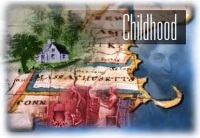
Mary Lyon was born February 28, 1797 on a remote New England farm. The Lyon family lived in Buckland, a town in the hills of western Massachusetts. Less than 50 years before her birth, Lyon's great-grandfathers had migrated from eastern Massachusetts and Connecticut to help settle the area and to farm the rocky hilltown soil. Her father, Aaron, fought in the Revolutionary War.
Aaron Lyon died when Mary was five, leaving his wife, Jemina, to raise seven children and manage a 100-acre farm on her own. At her mother's side, Mary Lyon learned the skills and crafts required of every early nineteenth-century New England farm girl. She cooked on the open hearth, baked bread, spun and dyed wool from the family sheep, wove coverlets, sewed clothes and embroidered linens, preserved fruits and vegetables picked from the family garden, churned butter, made cheese, jam, soap, and candles, cured meat, washed clothes, and swept floors. When Mrs. Lyon remarried and moved to her new husband's home, 13-year old Mary was left behind. Now, self-supporting, she kept house for her brother, Aaron, who ran the family farm. He paid his sister a weekly wage of one silver dollar.

Pin cushion and thimble owned by Mary Lyon.
Sewing, cooking, spinning, washing, and candle and butter making were just a few of Mary's many duties as a girl.
Mary Lyon began her education at age four in the village school, about a mile from her home. When the school was moved three years later to a more distant location, she left her family and lived for the school term with relatives and local families. She did chores to pay for her room and board. Mary Lyon was fortunate--girls could attend the Buckland school year-round. The school year was typically ten months long and divided into winter and summer terms. In some towns, girls could only attend during the summer, when boys were needed to do farm work. During winter, girls were forced to sit on the school steps, hoping to catch bits of the teacher's lessons.
As early as 1647, the Massachusetts Bay Colony made education compulsory for children. By the eighteenth century, most towns in Massachusetts had public elementary schools, which were called common schools. Some even had academies--the term used for high schools--which prepared young men for college. Girls, however, did not benefit from the colony's advanced ideas about education. Their schooling was uneven, at best, and frequently nonexistent. Many people felt that girls did not need to be educated to become wives and mothers and caretakers of the house. Although she left school when she was 13, Mary Lyon had more education than most girls, who knew little more than the basics of reading, writing, and math, and often not even that much.
What was life like during Mary Lyon's childhood in the early nineteenth century?
- Nights and winter days are dark.
- Candles and whale oil lamps provide the only artificial light.
- Roads are dirt, and often muddy. Macadam roads are introduced in 1812, but rural roads remain mostly dirt.
- There is no paper money until 1861. Coins are made of gold, silver and copper.
- Few people receive mail, and if they do, they have to pay the postage. Stamps, purchased by the sender, were not sold in the U.S. until 1847.
- People travel by foot, horseback, carriage, stagecoach, and, in winter, sleigh.
- Quill pens made from the shaft of a feather are used for writing.
- Few people own books other than the Bible. Many, especially women and girls, do not have sufficient literacy skills to read a book or a newspaper or write much more than their name.
- In 1803, the U.S. pays France $15 million for the Louisiana Purchase, which doubles the size of the young nation and spurs migration west.
- John Adams, Thomas Jefferson, and James Madison serve as presidents.
- In 1800, the U.S. population is 5,308,483; in 1809, the national debt is $60 million. (Do you know what it is today?)


Explore the MHC Social Universe >